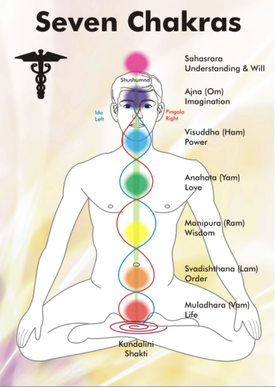|
There are seven major chakras that interact with the body, and the eight one encompasses them all. All the main chakras are connected by a channel of energy known as the Shushmana that travels up the center of the spine and around the brain. Even though they are unseen, our chakras interact with and influence our thoughts, moods and health. When any of our chakras get blocked, energy ceases to flow smoothly through the body causing a sense of imbalance. Each Chakra plays an important function and connects to different vital organs within us. 1. The Sahasra or crown Chakra located at the top of our head connects us to the spiritual world and serves to integrate all levels of our consciousness. Imbalances in this chakra can cause headaches, mental illnesses, brain disorders and coordination problems, epilepsy, blood vessel problems, and skin disorders. 2. The Ajna or third-eye chakra located between our eyes encourages us to listen and trust our intuition and insight and releasing hidden and repressed negative thoughts. One of the most important chakras with regards to depression, a blockage of this chakra can result in mood swings, anger and sleep disorders. 3. The Visuddha or the throat chakra – located as the name suggests in the neck region, is connected to our speech faculties and our ability to express ourselves. When this chakra is out of alignment, it can result in thyroid imbalances, swollen glands, mouth, jaw, tongue, neck and shoulders problems, hyperactivity and hormonal disorders such as PMS, mood swings, bloating and menopause. 4. Next is the Anhata or heart chakra associated with emotions, the heart and feelings of empathy, love, forgiveness and self-acceptance. A slowdown in energy flowing through this chakra can result in problems associated with the heart, breathing disorders, heart and breast cancer, chest pain, high blood pressure immune system problems and muscular tension. 5. Located just above the navel, the Manipuri or Solar plexus chakra controls our sense of self, confidence and intellect. This chakra is associated with digestive problems, ulcers, diabetes, hypoglycemia, constipation, nervousness, toxicity, parasites, colitis and poor memory. Emotional imbalances include issues of personal power and self-esteem, our inner critic comes out and fears of rejection and criticism. 6. The Svadisthana or spleen chakra located in the lower abdomen. Connected to our sensing abilities and issues related to feelings and the ability to be social. A lack of energy flow to this chakra is associated with reproductive issues, urinary problems, kidney dysfunctions, hip, and pelvic and low back pain. Emotional imbalances include our commitment to relationships. Our ability to express our emotions; our ability to have fun, play based on desires, creativity, pleasure, sexuality and fears of impotence, betrayal, addictions. When this chakra is balanced, we have an ability to take risks, we are creative; we are committed. 7. The root or the Muladhara chakra situated at the base of the spine and one of the most important chakras deals with basic survival and the right to exist. Physical imbalances in the root chakra include problems in the legs, feet, rectum, tailbone, immune system, male reproductive parts and prostrate gland. Those with imbalances here are also likely to experience issues of degenerative arthritis, knee pain, sciatica, eating disorders, and constipation. Emotional imbalances include feelings affecting our basic survival needs: money, shelter and food:; ability to provide for life’s necessities. When this chakra is balance, you feel supported, a sense of connection and safety to the physical world, and grounded. 8. The energy field that surrounds our bodybody, as a whole is known as the Aura. The aura is the protective shield that encloses the other chakras. It changes in colour, brightness and size depending on your general physical health, thoughts and feelings. The aura normally extends several feet in every direction and can grow brighter and larger with consistent healthy body, mind and spirit practice such as Kundalini yoga and meditation. So how do we balance the Chakras? Kundalini yoga and meditation are powerful tools to activate, transform and balance the chakras in the body. Another effective way of balancing our chakras is by using the power of positive affirmations. Our thoughts create our reality, and by regularly practicing positive affirmations we can achieve positive results in our lives. Here is an example of a positive affirmation to balance the throat chakra. “Consciously breathe deeply with the focus on the throat and affirm ‘I feel safe, my thoughts are positive and I feel supported by the universe to express freely what I want” When the Chakras are balanced, one is able to experience a shift in attitude and awareness. After the Kundalini energy rises and becomes accustomed to flowing freely through all the chakras, there is definite change of consciousness, a noticeable transformation in the character of an individual. The person achieves balance, a sense of being centered, and a world -view of a raised sense of consciousness, causing a transformation in their behaviour Stay healthy, happy and holy Satnam  Do you feel like there is something missing in your life? Is it love, prosperity, success, the ability to express your self freely or something else? Are you fearful? Are you depressed? Balancing your energy centers may help… Find out which energy center is blocked and what you can do to bring them into alignment. Our bodies are made up of energy centers that are in constant state of motion and realignment in complex patterns. The yogic name for these centers is Chakras.
0 Comments
Leave a Reply. |
News & VideosHello. This is where we will be posting regular updates, videos, articles and tips. Categories
All
|
 RSS Feed
RSS Feed